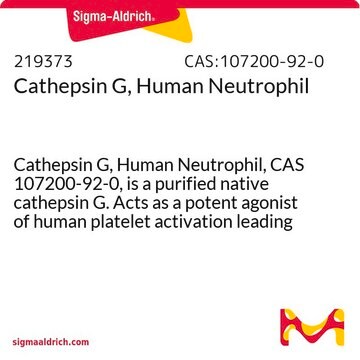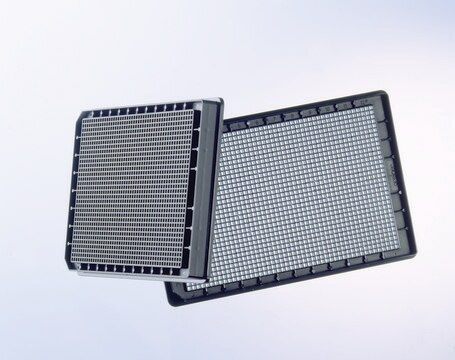MABT1240
Anti-Cathepsin G Antibody, clone AHN-11, Ascites Free
clone AHN-11, from mouse
Synonym(s):
Cathepsin G, CatG, CG
About This Item
Recommended Products
biological source
mouse
Quality Level
antibody form
purified immunoglobulin
antibody product type
primary antibodies
clone
AHN-11, monoclonal
species reactivity
human
technique(s)
ELISA: suitable
immunocytochemistry: suitable
radioimmunoassay: suitable
western blot: suitable
isotype
IgG2aκ
NCBI accession no.
UniProt accession no.
target post-translational modification
unmodified
Gene Information
human ... CTSG(1511)
General description
Specificity
Immunogen
Application
Cell Structure
Inflammation & Autoimmune Mechanisms
Immunocytochemistry Analysis: Clone AHN-11 hybridoma culture supernatant immunostained ethanol-fixed human neutrophils, but not other peripheral blood cells, including platelets, lymphocytes, and eosinophils. Faint immunostaining of some monocytes was occasionally detected (Skubitz, K.M., et al. (1989). J. Leukoc. Biol. 46(2):109-118).
ELISA Analysis: A representative lot captured cathepsin G from human neutrophil granule extract. The captured cathepsin G served to detect the presence of serum cathepsin G autoantibody levels in patients serum samples (Ellerbroek, P.M., et al. (1994). J. Clin. Pathol. 47(3):257-262).
Radioimmunoassay Analysis: Clone AHN-11 hybridoma culture supernatant bound to well surface coated with dried human neutrophils, but not platelets or erythrocytes by solid-phase radioimmunoassay (Skubitz, K.M., et al. (1989). J. Leukoc. Biol. 46(2):109-118).
Radioimmunoassay Analysis: Clone AHN-11 hybridoma culture supernatant bound to well surface coated with content of primary granule, but not secondary granule, plasma membrane, or cytoplasm fraction from neutrophils by solid-phase radioimmunoassay (Skubitz, K.M., et al. (1989). J. Leukoc. Biol. 46(2):109-118).
Radioimmunoassay Analysis: Clone AHN-11 hybridoma culture supernatant reacted with purified human cathepsin G, but not elastase, EPO, esterase N, proteinase 3, plamin, kallidrein, lactoferrin, MBP, or thrombin by solid-phase radioimmunoassay (Skubitz, K.M., et al. (1989). J. Leukoc. Biol. 46(2):109-118).
Quality
Immunocytochemistry Analysis: A 1:200 dilution of this antibody detected Cathepsin G in HL60 human promyelocytic leukemia cells.
Target description
Linkage
Physical form
Storage and Stability
Other Notes
Disclaimer
Not finding the right product?
Try our Product Selector Tool.
Storage Class
12 - Non Combustible Liquids
wgk_germany
WGK 1
flash_point_f
Not applicable
flash_point_c
Not applicable
Certificates of Analysis (COA)
Search for Certificates of Analysis (COA) by entering the products Lot/Batch Number. Lot and Batch Numbers can be found on a product’s label following the words ‘Lot’ or ‘Batch’.
Already Own This Product?
Find documentation for the products that you have recently purchased in the Document Library.
Our team of scientists has experience in all areas of research including Life Science, Material Science, Chemical Synthesis, Chromatography, Analytical and many others.
Contact Technical Service








